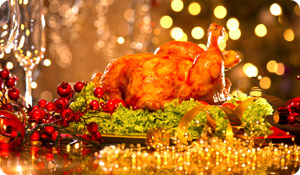
If you're like many people, you have a love-hate relationship with the holidays—especially when it comes to traditional holiday food and drink. As the weather cools and the leaves drop, you start looking forward to Aunt Sandy's buttery Christmas cookies and Uncle Tony's famous lasagna. But you hate where the needle on the scale lands come January 2. How can you navigate the end-of-the-year food parade without compromising your health or your pants size? Here's a handy guide to the best and worst holiday treats, so you can enjoy the season without too much guilt.
Go for It!
The following foods should be on your "do eat" list:
- Nuts. Yes, nuts are relatively high in calories and fat, but the fat is the heart-healthy kind. So a pre-dinner snack of almonds, walnuts, or peanuts is fine as long as you keep the portion size reasonable and avoid nuts that are covered in salt or sugar (or chocolate).
- Crudites. A colorful platter of raw veggies is the perfect accompaniment to any holiday meal. "All the nutritional experts agree—the more fruits and vegetables in your diet, the better," says Dana Simpler, MD, a physician at Mercy Medical Center in Baltimore. Substitute guacamole or salsa for sour cream-based dips, or try tangy, fat-free Greek yogurt mixed with seasoning for a healthier accompaniment.
- Beans and grains. You don't have to be a vegetarian to reap the benefits of meatless meals. Chick pea-based hummus is a great substitute for fatty sour cream dip, while quinoa offers a hefty dose of fiber and protein. When making her favorite potato salad, Simpler likes to blend white beans with vinegar and mustard in a food processor for a creamy, tangy sauce with far fewer calories and fat grams than traditional mayonnaise dressings.
- Turkey. Although turkeys have bred to be fatter than ever, in general the bird is a good meal option. "Turkey is naturally lean, which means it contains less saturated (heart-harming) fat [than other meats] and is a great source of protein," says Neal G. Malik, DrPH, RD, a registered dietitian at the University of California, Riverside. "A hefty five-ounce portion is only 268 calories and provides 40 grams of protein." He suggests peeling off the skin to save significant fat calories, especially if the turkey is deep-fried.
Proceed With Caution
Watch your portion size with these holiday favorites:
- Ham. If there's an alternative, such as turkey or a meatless entree, consider that instead—or, at least limit your portion size. Why? "It's fatty, it's cured, it's salty," says Simpler, who recommends a completely plant-based diet for people who suffer from heart disease.
- Mashed potatoes. A medium potato has 170 calories, no fat, and about a third of the recommended daily allowance of vitamin C. But you’re unlikely to come across mashed potatoes that haven’t been dressed with heaps of butter and salt, so tread lightly here.
- Sweet potatoes. Again, sweet potatoes by themselves are loaded with nutrients—especially vitamin A—a half cup contains 520 percent of your recommended daily allowance! But when mashed and loaded with marshmallows, sugar, and butter, they're less of a health bargain. Keep your portion to a half cup. Better yet, go for plain yams if you can. They're naturally sweet, and one cup is just 155 calories.
Stop!
Try to avoid the following dishes:
- Stuffing. Stuffing can be tough to resist, but when you consider that one butter-drenched cup contains a whopping 875 calories, it may become less appetizing. “This is more than a meal's worth [of calories] on its own,” Malik says. A better choice: rice or a small serving of pasta.
- Pie. There's no getting around the fact that pie is a real indulgence, but pick wisely and you can still enjoy a small portion. "Choose a slice of pumpkin pie over pecan pie to save about 185 calories per slice," suggests Tracy Noerper, MS, RD, LDN, a registered dietitian at Middle Tennessee State University in Murfreesboro. "Skip eating the crust and save even more fat and calories." And if you're doing the cooking or baking, Simpler suggests replacing sugar with the same amount of applesauce.
- Eggnog. A fat-filled sugar fest, this one is hard to justify. If you must have eggnog, buy or make a reduced-fat variety. Better yet, go for reduced-sugar hot chocolate (made with water or low fat milk), a wine spritzer, or sparkling water.
Dana Simpler, MD, reviewed this article.
Sources
Neal G. Malik, University of California, Riverside. Email, November 19, 2014.
Tracy Noerper, Middle Tennessee State University. Email exchange, November 24-December 3, 2014.
Dana Simpler, MD, Mercy Medical Center. Phone call with source, November 19, 2014.
"Potatoes, Russet, Fresh."United States Department of Agriculture, Household USDA Foods Fact Sheet. Accessed December 2, 2014.
"Sweet Potatoes and Yams." United States Department of Agriculture, SNAP-Ed Connection. Accessed December 2, 2014.
"Basic Report: 18081, Bread Stuffing, Bread, Dry Mix." United States Department of Agriculture, National Nutrient Database for Standard Reference. Accessed December 2, 2014.





